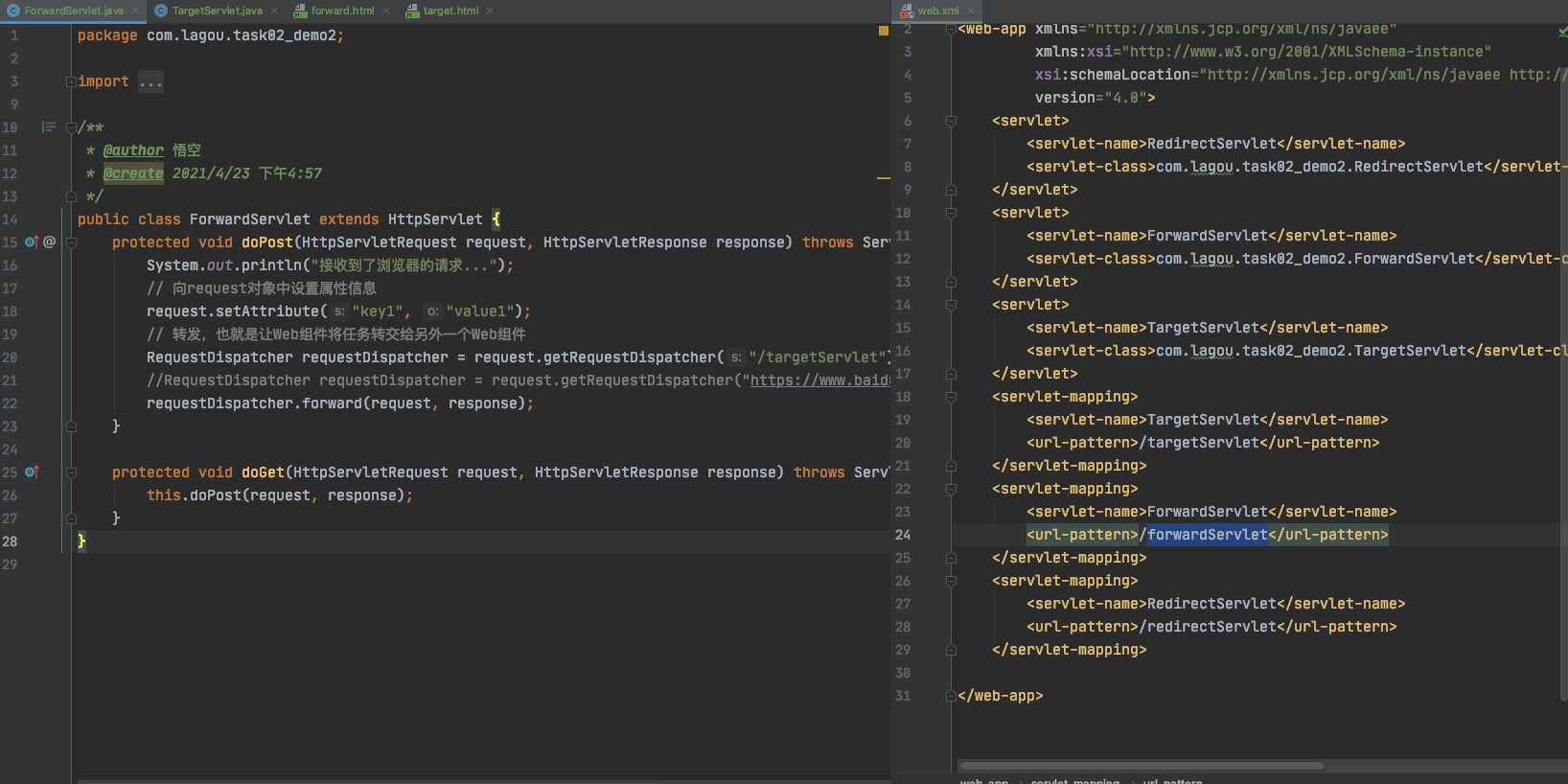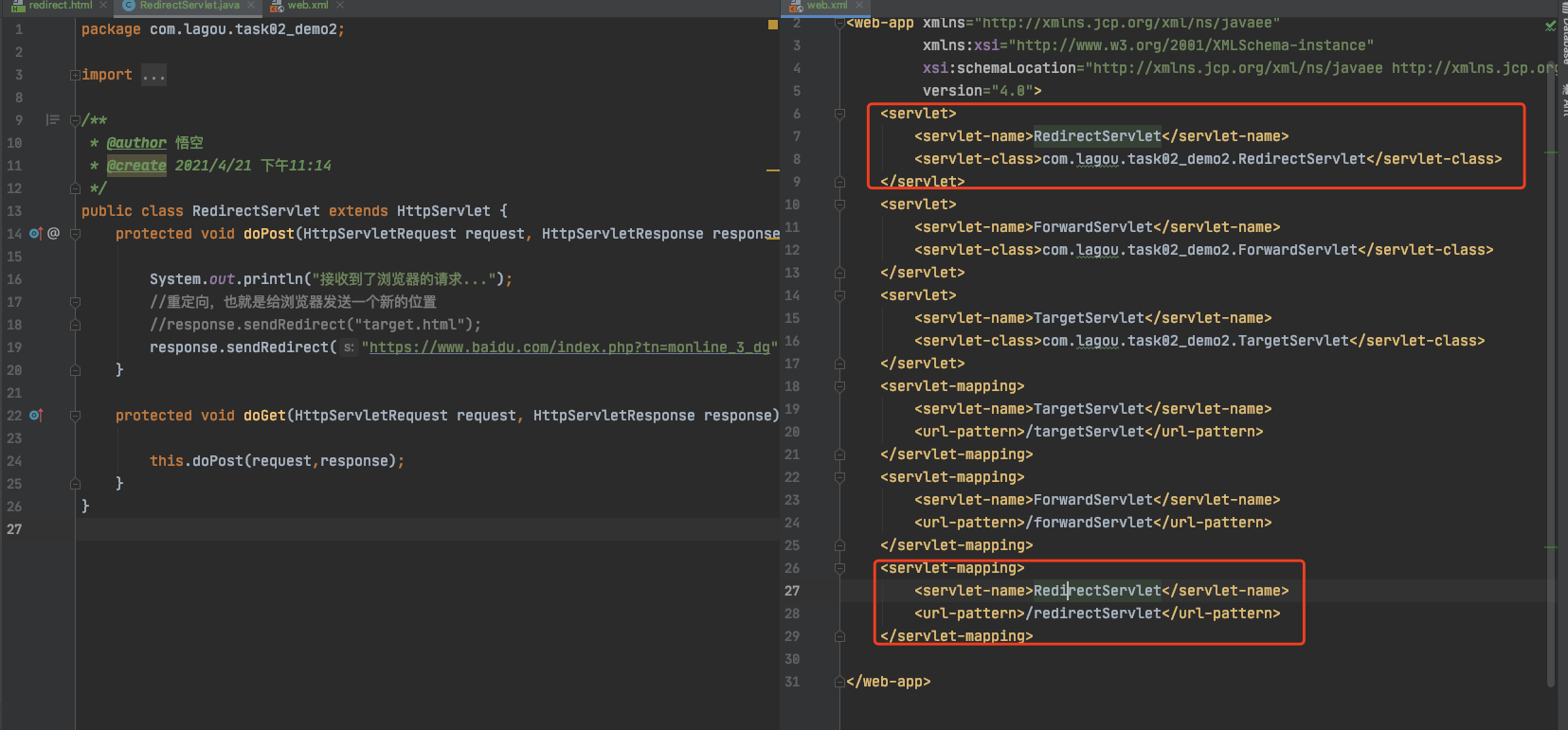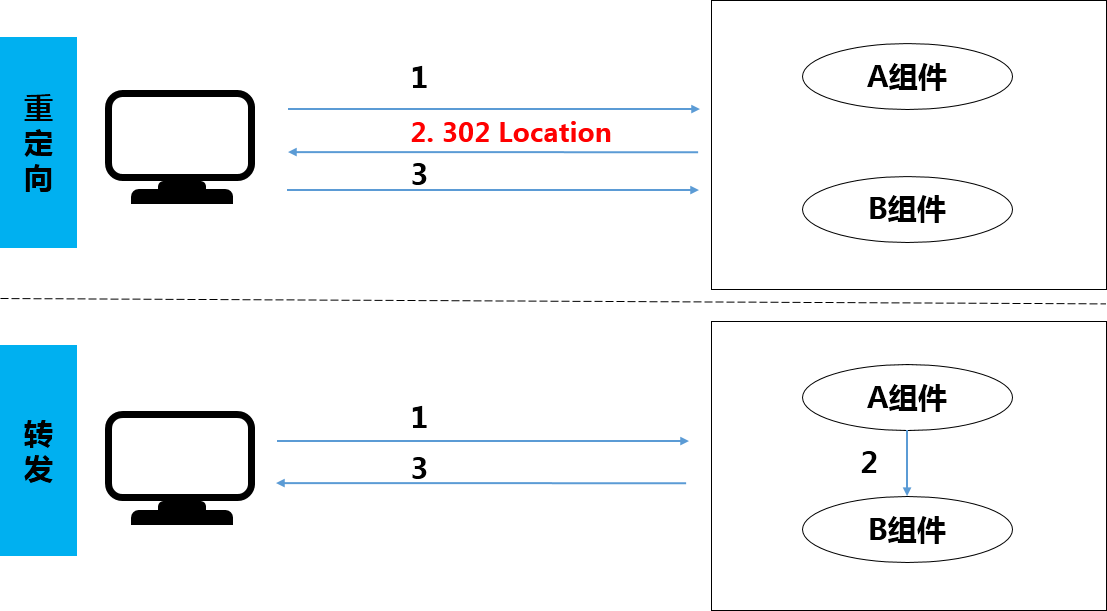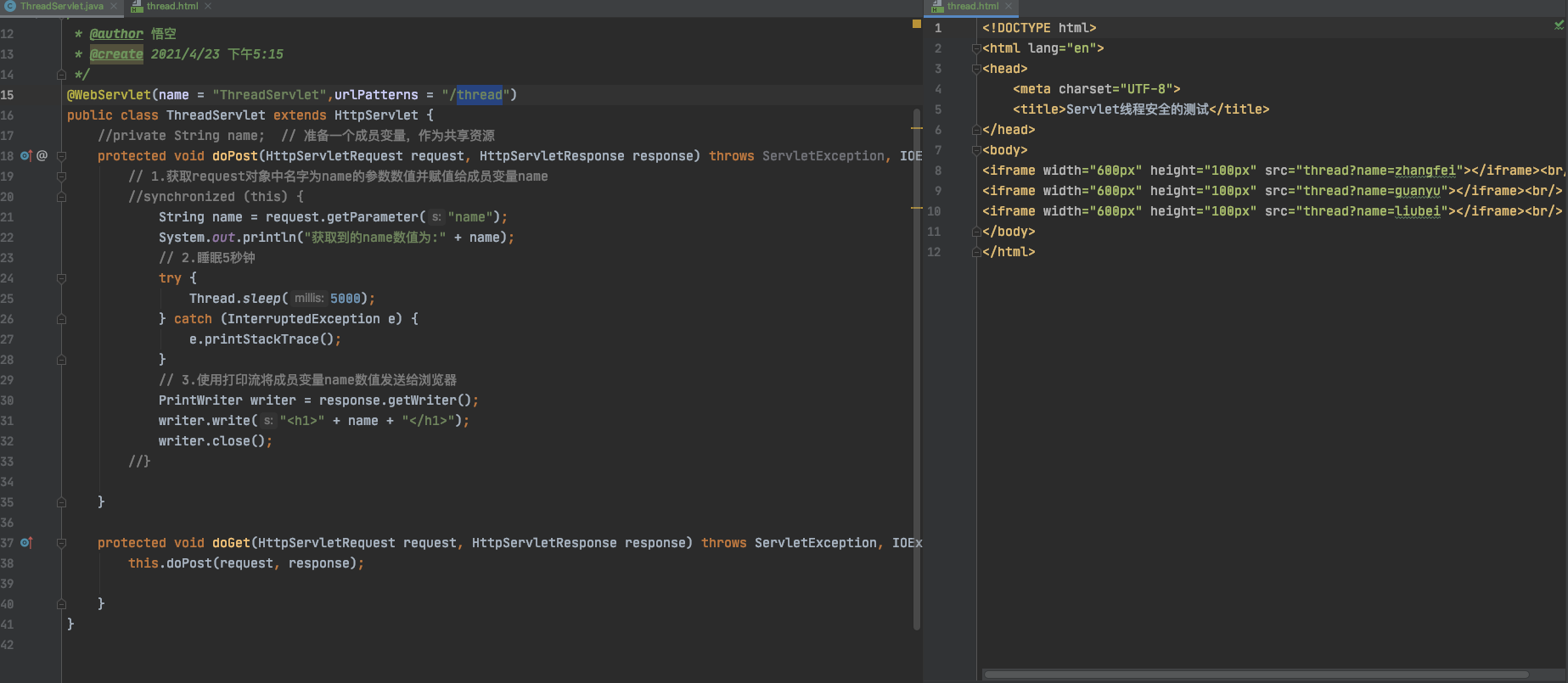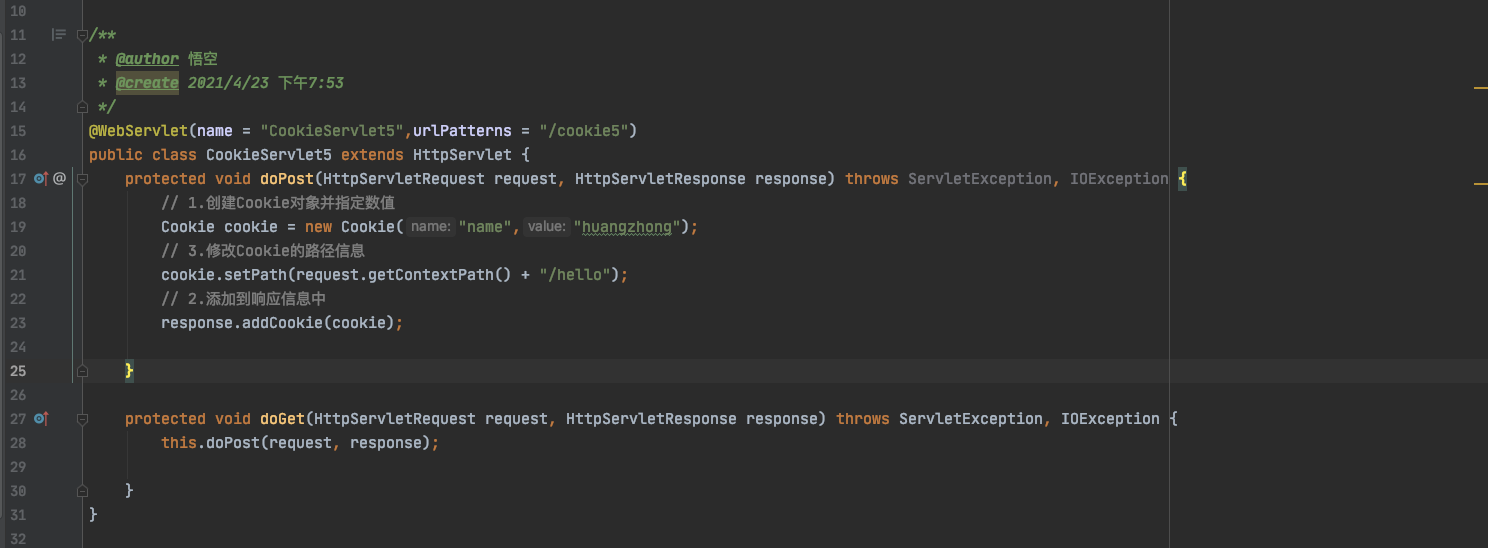Servlet+JDBC应用(重点)
- 在Servlet中可以使用JDBC技术访问数据库,常见功能如下:
查询DB数据,然后生成显示页面,例如:列表显示功能。
接收请求参数,然后对DB操作,例如:注册、登录、修改密码等功能。
- 为了方便重用和便于维护等目的,经常会采用DAO(Data Access Object)模式对数据库操作进行独立封装。

- DAO工厂(工厂模式)
重定向和转发(重点)
重定向的概述
1. 重定向的概念
首先客户浏览器发送http请求,当web服务器接受后发送302状态码响应及对应新的location给客 户浏览器,客户浏览器发现是302响应,则自动再发送一个新的http请求,请求url是新的location地址,服务器根据此请求寻找资源并发送给客户。
2. 重定向的实现
实现重定向需要借助javax.servlet.http.HttpServletResponse接口中的以下方法:
| 方法声明 | 功能介绍 |
|---|---|
| void sendRedirect(String location) | 使用指定的重定向位置URL向客户端发送临时重定向响应 |
3. 重定向的原理
4. 重定向的特点
- 重定向之后,浏览器地址栏的URL会发生改变。
- 重定向过程中会将前面Request对象销毁,然后创建一个新的Request对象。
- 重定向的URL可以是其它项目工程。
redirect.html
<!DOCTYPE html><html lang="en"><head><meta charset="UTF-8"><title>重定向</title></head><body><form action="redirectServlet" method="post"><input type="submit" value="重定向"/></form></body></html>
RedirectServlet.java
package com.lagou.task02_demo2;import javax.servlet.ServletException;import javax.servlet.http.HttpServlet;import javax.servlet.http.HttpServletRequest;import javax.servlet.http.HttpServletResponse;import java.io.IOException;/*** @author 悟空* @create 2021/4/21 下午11:14*/public class RedirectServlet extends HttpServlet {protected void doPost(HttpServletRequest request, HttpServletResponse response) throws ServletException, IOException {System.out.println("接收到了浏览器的请求...");//重定向,也就是给浏览器发送一个新的位置//response.sendRedirect("target.html");response.sendRedirect("https://www.baidu.com/index.php?tn=monline_3_dg");}protected void doGet(HttpServletRequest request, HttpServletResponse response) throws ServletException, IOException {this.doPost(request,response);}}
转发的概述
1. 转发的概念
一个Web组件(Servlet/JSP)将未完成的处理通过容器转交给另外一个Web组件继续处理,转发的各个组件会共享Request和Response对象。
2. 转发的实现
绑定数据到Request对象 | 方法声明 | 功能介绍 | | —- | —- | | Object getAttribute(String name) | 将指定属性值作为对象返回,若给定名称属性不存在,则返回空值 | | void setAttribute(String name,Object o) | 在此请求中存储属性值 |
获取转发器对象 | 方法声明 | 功能介绍 | | —- | —- | | RequestDispatcher getRequestDispatcher(String path) | 返回一个RequestDispatcher对象,该对象充当位于给定路径上的资源的包装器 |
转发操作 | 方法声明 | 功能介绍 | | —- | —- | | void forward(ServletRequest request, ServletResponse response) | 将请求从一个servlet转发到服务器上的另一个资源(Servlet、JSP文件或HTML文件) |
3. 转发的特点
转发之后浏览器地址栏的URL不会发生改变。转发过程中共享Request对象。
转发的URL不可以是其它项目工程。
forward.html
<!DOCTYPE html><html lang="en"><head><meta charset="UTF-8"><title>转发的测试</title></head><body><form action="forwardServlet" method="post"><input type="submit" value="转发"/></form></body></html>
target.html
<!DOCTYPE html><html lang="en"><head><meta charset="UTF-8"><title>重定向后的页面</title></head><body><h1>服务器重新指定位置后的页面</h1></body></html>
ForwardServlet.java
package com.lagou.task02_demo2;import javax.servlet.RequestDispatcher;import javax.servlet.ServletException;import javax.servlet.http.HttpServlet;import javax.servlet.http.HttpServletRequest;import javax.servlet.http.HttpServletResponse;import java.io.IOException;/*** @author 悟空* @create 2021/4/23 下午4:57*/public class ForwardServlet extends HttpServlet {protected void doPost(HttpServletRequest request, HttpServletResponse response) throws ServletException, IOException {System.out.println("接收到了浏览器的请求...");// 向request对象中设置属性信息request.setAttribute("key1", "value1");// 转发,也就是让Web组件将任务转交给另外一个Web组件RequestDispatcher requestDispatcher = request.getRequestDispatcher("/targetServlet");//RequestDispatcher requestDispatcher = request.getRequestDispatcher("https://www.baidu.com/index.php?tn=monline_3_dg");requestDispatcher.forward(request, response);}protected void doGet(HttpServletRequest request, HttpServletResponse response) throws ServletException, IOException {this.doPost(request, response);}}
TargetServlet.java
package com.lagou.task02_demo2;import javax.servlet.ServletException;import javax.servlet.http.HttpServlet;import javax.servlet.http.HttpServletRequest;import javax.servlet.http.HttpServletResponse;import java.io.IOException;/*** @author 悟空* @create 2021/4/23 下午5:01*/public class TargetServlet extends HttpServlet {protected void doPost(HttpServletRequest request, HttpServletResponse response) throws ServletException, IOException {System.out.println("转发过来了...");// 获取request对象中的属性值判断是否共享Object key1 = request.getAttribute("key1");System.out.println("获取到的属性值为:" + key1); // value1// 通过打印流向页面写入转发成功的信息response.setContentType("text/html;charset=utf-8");response.getWriter().write("<h1>转发成功!</h1>");}protected void doGet(HttpServletRequest request, HttpServletResponse response) throws ServletException, IOException {this.doPost(request, response);}}
4. 重定向和转发的比较
Servlet线程安全(重点)
- 服务器在收到请求之后,会启动一个线程来进行相应的请求处理。
- 默认情况下,服务器为每个Servlet只创建一个对象实例。当多个请求访问同一个Servlet时,会有多个线程访问同一个Servlet对象,此时就可能发生线程安全问题。
- 多线程并发逻辑,需要使用synchronized对代码加锁处理,但尽量避免使用。
状态管理(重点)
- Web程序基于HTTP协议通信,而HTTP协议是”无状态”的协议,一旦服务器响应完客户的请求之后,就断开连接,而同一个客户的下一次请求又会重新建立网络连接。
- 服务器程序有时是需要判断是否为同一个客户发出的请求,比如客户的多次选购商品。因此,有必要跟踪同一个客户发出的一系列请求。
- 把浏览器与服务器之间多次交互作为一个整体,将多次交互所涉及的数据保存下来,即状态管理。
- 多次交互的数据状态可以在客户端保存,也可以在服务器端保存。状态管理主要分为以下两类:
客户端管理:将状态保存在客户端。基于Cookie技术实现。
服务器管理:将状态保存在服务器端。基于Session技术实现。
Cookie技术(重点)
基本概念
- Cookie本意为”饼干“的含义,在这里表示客户端以“名-值”形式进行保存的一种技术。
- 浏览器向服务器发送请求时,服务器将数据以Set-Cookie消息头的方式响应给浏览器,然后浏览器会将这些数据以文本文件的方式保存起来。
当浏览器再次访问服务器时,会将这些数据以Cookie消息头的方式发送给服务器。
相关的方法
使用javax.servlet.http.Cookie类的构造方法实现Cookie的创建。 | 方法声明 | 功能介绍 | | —- | —- | | Cookie(String name, String value) | 根据参数指定数值构造对象 |
使用javax.servlet.http.HttpServletResponse接口的成员方法实现Cookie的添加。 | 方法声明 | 功能介绍 | | —- | —- | | void addCookie(Cookie cookie) | 添加参数指定的对象到响应 |
package com.lagou.demo03.servlet;import javax.servlet.ServletException;import javax.servlet.annotation.WebServlet;import javax.servlet.http.Cookie;import javax.servlet.http.HttpServlet;import javax.servlet.http.HttpServletRequest;import javax.servlet.http.HttpServletResponse;import java.io.IOException;/*** @author 悟空* @create 2021/4/23 下午5:32*/@WebServlet(name = "CookieServlet",urlPatterns = "/cookie")public class CookieServlet extends HttpServlet {protected void doPost(HttpServletRequest request, HttpServletResponse response) throws ServletException, IOException {// 1.测试一下浏览器的请求是否达到System.out.println("看看有没有执行到这里哦!");// 2.创建Cookie对象并添加到响应信息中Cookie cookie = new Cookie("name","zhangfei");response.addCookie(cookie);System.out.println("创建Cookie成功!");}protected void doGet(HttpServletRequest request, HttpServletResponse response) throws ServletException, IOException {this.doPost(request, response);}}
- 使用javax.servlet.http.HttpServletRequest接口的成员方法实现Cookie对象的获取。 | 方法声明 | 功能介绍 | | —- | —- | | Cookie[] getCookies() | 返回此请求中包含的所有Cookie对象 |
package com.lagou.demo03.servlet;import javax.servlet.ServletException;import javax.servlet.annotation.WebServlet;import javax.servlet.http.Cookie;import javax.servlet.http.HttpServlet;import javax.servlet.http.HttpServletRequest;import javax.servlet.http.HttpServletResponse;import java.io.IOException;/*** @author 悟空* @create 2021/4/23 下午5:38*/@WebServlet(name = "CookieServlet2",urlPatterns = "/cookie2")public class CookieServlet2 extends HttpServlet {protected void doPost(HttpServletRequest request, HttpServletResponse response) throws ServletException, IOException {// 1.获取客户端发来的Cookie信息并打印出来Cookie[] cookies = request.getCookies();System.out.println("获取到的Cookie信息有:");for (Cookie tc: cookies) {System.out.println(tc.getName() + "对应的值为:" + tc.getValue());}}protected void doGet(HttpServletRequest request, HttpServletResponse response) throws ServletException, IOException {this.doPost(request, response);}}
- 使用javax.servlet.http.Cookie类的构造方法实现Cookie对象中属性的获取和修改。 | 方法声明 | 功能介绍 | | —- | —- | | String getName() | 返回此Cookie对象中的名字 | | String getValue() | 返回此Cookie对象的数值 | | void setValue(String newValue) | 设置Cookie的数值 |
package com.lagou.demo03.servlet;import javax.servlet.ServletException;import javax.servlet.annotation.WebServlet;import javax.servlet.http.Cookie;import javax.servlet.http.HttpServlet;import javax.servlet.http.HttpServletRequest;import javax.servlet.http.HttpServletResponse;import java.io.IOException;/*** @author 悟空* @create 2021/4/23 下午5:51*/@WebServlet(name = "CookieServlet3",urlPatterns = "/cookie3")public class CookieServlet3 extends HttpServlet {protected void doPost(HttpServletRequest request, HttpServletResponse response) throws ServletException, IOException {// 1.获取客户端发来的Cookie信息并打印出来Cookie[] cookies = request.getCookies();for (Cookie tc:cookies) {// 2.当获取到的Cookie对象的名字为name时,将对应的数值修改为guanyu并添加到响应信息中去if ("name".equalsIgnoreCase(tc.getName())){tc.setValue("guanyu");response.addCookie(tc);break;}}}protected void doGet(HttpServletRequest request, HttpServletResponse response) throws ServletException, IOException {this.doPost(request, response);}}
Cookie的生命周期
- 默认情况下,浏览器会将Cookie信息保存在内存中,只要浏览器关闭,Cookie信息就会消失。
- 如果希望关闭浏览器后Cookie信息仍有效,可以通过Cookie类的成员方法实现。 | 方法声明 | 功能介绍 | | —- | —- | | int getMaxAge() | 返回cookie的最长使用期限(以秒为单位) | | void setMaxAge(int expiry) | 设置cookie的最长保留时间(秒) |
package com.lagou.demo03.servlet;import javax.servlet.ServletException;import javax.servlet.annotation.WebServlet;import javax.servlet.http.Cookie;import javax.servlet.http.HttpServlet;import javax.servlet.http.HttpServletRequest;import javax.servlet.http.HttpServletResponse;import java.io.IOException;/*** @author 悟空* @create 2021/4/23 下午5:58*/@WebServlet(name = "CookieServlet4",urlPatterns = "/cookie4")public class CookieServlet4 extends HttpServlet {protected void doPost(HttpServletRequest request, HttpServletResponse response) throws ServletException, IOException {// 1.创建Cookie信息Cookie cookie = new Cookie("name","liubei");// 2.获取Cookie信息的默认使用期限int maxAge = cookie.getMaxAge();System.out.println("该Cookie的默认使用期限是:" + maxAge);// 3.修改Cookie信息的使用期限// 正数表示在指定的秒数后失效 负数表示浏览器关闭后失效 0表示马上失效//cookie.setMaxAge(0);cookie.setMaxAge(60*10);// 4.添加到响应信息中response.addCookie(cookie);System.out.println("设置Cookie的声明周期成功!");}protected void doGet(HttpServletRequest request, HttpServletResponse response) throws ServletException, IOException {this.doPost(request, response);}}
Cookie的路径问题
- 浏览器在访问服务器时,会比较Cookie的路径与请求路径是否匹配,只有匹配的Cookie才会发送给服务器。
- Cookie的默认路径等于添加这个Cookie信息时的组件路径,例如:/项目名/目录/add.do请求添加 了一个Cookie信息,则该Cookie的路径是 /项目名/目录。
- 访问的请求地址必须符合Cookie的路径或者其子路径时,浏览器才会发送Cookie信息。 | 方法声明 | 功能介绍 | | —- | —- | | void setPath(String uri) | 设置cookie的路径信息 |
package com.lagou.demo03.servlet;import javax.servlet.ServletException;import javax.servlet.annotation.WebServlet;import javax.servlet.http.Cookie;import javax.servlet.http.HttpServlet;import javax.servlet.http.HttpServletRequest;import javax.servlet.http.HttpServletResponse;import java.io.IOException;/*** @author 悟空* @create 2021/4/23 下午7:53*/@WebServlet(name = "CookieServlet5",urlPatterns = "/cookie5")public class CookieServlet5 extends HttpServlet {protected void doPost(HttpServletRequest request, HttpServletResponse response) throws ServletException, IOException {// 1.创建Cookie对象并指定数值Cookie cookie = new Cookie("name","huangzhong");// 3.修改Cookie的路径信息cookie.setPath(request.getContextPath() + "/hello");// 2.添加到响应信息中response.addCookie(cookie);}protected void doGet(HttpServletRequest request, HttpServletResponse response) throws ServletException, IOException {this.doPost(request, response);}}
Cookie的特点
- Cookie技术不适合存储所有数据,程序员只用于存储少量、非敏感信息,原因如下:
将状态数据保存在浏览器端,不安全。
保存数据量有限制,大约4KB左右。
只能保存字符串信息。
可以通过浏览器设置为禁止使用。
Session技术(重点)
基本概念
- Session本意为”会话”的含义,是用来维护一个客户端和服务器关联的一种技术。
- 浏览器访问服务器时,服务器会为每一个浏览器都在服务器端的内存中分配一个空间,用于创建一个Session对象,该对象有一个id属性且该值唯一,我们称为SessionId,并且服务器会将这个SessionId以Cookie方式发送给浏览器存储。
- 浏览器再次访问服务器时会将SessionId发送给服务器,服务器可以依据SessionId查找相对应的
相关的方法
使用javax.servlet.http.HttpServletRequest接口的成员方法实现Session的获取。 | 方法声明 | 功能介绍 | | —- | —- | | HttpSession getSession() | 返回此请求关联的当前Session,若此请求没有则创建一个 |
使用javax.servlet.http.HttpSession接口的成员方法实现判断和获取。 | 方法声明 | 功能介绍 | | —- | —- | | boolean isNew() | 判断是否为新创建的Session | | String getId() | 获取Session的编号 |
package com.lagou.demo03.servlet;import javax.servlet.ServletException;import javax.servlet.annotation.WebServlet;import javax.servlet.http.HttpServlet;import javax.servlet.http.HttpServletRequest;import javax.servlet.http.HttpServletResponse;import javax.servlet.http.HttpSession;import java.io.IOException;/*** @author 悟空* @create 2021/4/23 下午7:58*/@WebServlet(name = "SessionServlet",urlPatterns = "/session")public class SessionServlet extends HttpServlet {protected void doPost(HttpServletRequest request, HttpServletResponse response) throws ServletException, IOException {// 1.调用getSession对象获取或者创建Session对象HttpSession session = request.getSession();// 2.判断Session对象是否为新建的独享System.out.println(session.isNew()?"新建的Session对象":"已有的Session对象");// 3.获取编号并打印String id = session.getId();System.out.println("获取到的Session编号为:" + id);}protected void doGet(HttpServletRequest request, HttpServletResponse response) throws ServletException, IOException {this.doPost(request, response);}}
- 使用javax.servlet.http.HttpSession接口的成员方法实现属性的管理。 | 方法声明 | 功能介绍 | | —- | —- | | Object getAttribute(String name) | 返回在此会话中用指定名称绑定的对象,如果没有对象在该名称下绑定,则返回空值 | | void setAttribute(String name, Object value) | 使用指定的名称将对象绑定到此会话 | | void removeAttribute(String name) | 从此会话中删除与指定名称绑定的对象 |
package com.lagou.demo03.servlet;import javax.servlet.ServletException;import javax.servlet.annotation.WebServlet;import javax.servlet.http.HttpServlet;import javax.servlet.http.HttpServletRequest;import javax.servlet.http.HttpServletResponse;import javax.servlet.http.HttpSession;import java.io.IOException;/*** @author 悟空* @create 2021/4/23 下午8:09*/@WebServlet(name = "SessionServlet2",urlPatterns = "/session2")public class SessionServlet2 extends HttpServlet {protected void doPost(HttpServletRequest request, HttpServletResponse response) throws ServletException, IOException {HttpSession session = request.getSession();// 1.设置属性名和属性值session.setAttribute("name","machao");// 2.获取指定属性名对应的属性值System.out.println("获取到的属性值为:" + session.getAttribute("name")); // machao// 3.删除指定的属性名session.removeAttribute("name");// 4.获取指定属性名对应的属性值System.out.println("获取到的属性值为:" + session.getAttribute("name")); //null}protected void doGet(HttpServletRequest request, HttpServletResponse response) throws ServletException, IOException {this.doPost(request, response);}}
Session的生命周期
- 为了节省服务器内存空间资源,服务器会将空闲时间过长的Session对象自动清除掉,服务器默认的超时限制一般是30分钟。
- 使用javax.servlet.http.HttpSession接口的成员方法实现失效实现的获取和设置。 | 方法声明 | 功能介绍 | | —- | —- | | int getMaxInactiveInterval() | 获取失效时间 | | void setMaxInactiveInterval(int interval) | 设置失效时间 |
package com.lagou.demo03.servlet;import javax.servlet.ServletException;import javax.servlet.annotation.WebServlet;import javax.servlet.http.HttpServlet;import javax.servlet.http.HttpServletRequest;import javax.servlet.http.HttpServletResponse;import javax.servlet.http.HttpSession;import java.io.IOException;/*** @author 悟空* @create 2021/4/23 下午8:14*/@WebServlet(name = "SessionServlet3",urlPatterns = "/session3")public class SessionServlet3 extends HttpServlet {protected void doPost(HttpServletRequest request, HttpServletResponse response) throws ServletException, IOException {// 1.获取Session对象HttpSession session = request.getSession();// 2.获取对象的默认失败时间并打印int maxInactiveInterval = session.getMaxInactiveInterval();System.out.println("获取到的失效时间为:" + maxInactiveInterval); // 1800// 3.修改实现时间后重新获取并打印session.setMaxInactiveInterval(1200);maxInactiveInterval = session.getMaxInactiveInterval();System.out.println("获取到的失效时间为:" + maxInactiveInterval); // 1200}protected void doGet(HttpServletRequest request, HttpServletResponse response) throws ServletException, IOException {this.doPost(request, response);}}
可以配置web.xml文件修改失效时间。
<session-config><session-timeout>30</session-timeout></session-config>
Session的特点
- 数据比较安全。
- 能够保存的数据类型丰富,而Cookie只能保存字符串。
- 能够保存更多的数据,而Cookie大约保存4KB。
- 数据保存在服务器端会占用服务器的内存空间,如果存储信息过多、用户量过大,会严重影响服务器的性能。
